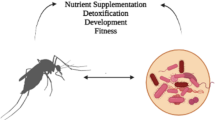Abstract
Parasitism results in nutritionally related changes in hosts, often leading to altered feeding behavior. Infected hosts that increase their feeding also increase their probability of reinfection. To study this, I used a beetle (Tenebrio molitor)–tapeworm (Hymenolepis diminuta) system. Infected and uninfected male and female beetles were individually housed in vials with food. Each beetle's weight change, food intake, and frass production were measured over 24-h periods at 3, 7, 12, and 16 days postinfection. Treatment (infection) had no effect on weight change, but males lost more weight and produced more frass than females. Additionally, treatment had no effect on food consumption, but males had a higher food intake than females. These results suggest that infection status will not alter the probability of reinfection, but males will be more susceptible to infection than females. However, despite the male's greater food intake during the experimental infection period, parasite loads did not differ between males and females.

Similar content being viewed by others
References
Bhattacharya AK, Ameel JJ, Waldebauer GP (1970) A method for sexing living pupal and adult yellow mealworms. Ann Entomol Soc Am 63:1783
Downer RGH (1981) Energy metabolism in insects, 1st edn. Plenum, New York
Edwards GA (1946) The influence of temperature upon the oxygen consumption of several arthropods. J Cell Comp Physiol 27:53–64
Gray DA (1998) Sex differences in susceptibility of house crickets, Acheta domesticus, to experimental infection with Serratia liquefaciens. J Invertebr Pathol 71:288–289
Hollander M, Wolfe DA (1999) Nonparametric statistical methods, 2nd edn. Wiley, New York
Hurd H, Arme C (1984) Tenebrio molitor (Coleoptera): effect of metacestodes of Hymenolepis diminuta (Cestoda) on haemolymph amino acids. Parasitology 89:245–251
Hurd H, Warr E, Polwart A (2001) A parasite that increases host lifespan. Proc R Soc Lond B 268:1749–1753
Kearns J, Hurd H, Pullin AS (1994) The effect of metacestodes of the rat tapeworm, Hymenolepis diminuta, on storage and circulating carbohydrates in the intermediate host, Tenebrio molitor. Parasitology 108:473–478
Lethbridge RC (1971) The hatching of Hymenolepis diminuta on the survival and fecundity of the intermediate host Tribolium confusum. Parasitology 64:405–412
Marron MT, Markow TA, Kain KJ, Gibbs, AG (2003) Effects of starvation and desiccation on energy metabolism in desert and mesic Drosophila. J Insect Physiol 49:261–270
Minitab v. 13.1 (2000) Minitab, State College, PA
Pappas PW, Leiby DA (1986) Variation in the sizes of eggs and oncospheres and the numbers and distributions of testes in the tapeworm, Hymenolepis diminuta. J Parasitol 72:383–391
Pappas PW, Marschall EA, Morrison SE, Durka GM, Daniel CS (1995) Increased coprophagic activity of the beetle, Tenebrio molitor, on feces containing eggs of the tapeworm, Hymenolepis diminuta. Int J Parasitol 25:1179–1184
Rau ME (1979) The frequency distribution of Hymenolepis diminuta cysticercoids in natural, sympatric populations of Tenebrio molitor and T. obscurus. Int J Parasitol 9:85–87
Rogowitz GL, Chappell MA (2000) Energy metabolism of eucalyptus-boring beetles at rest and during locomotion: gender makes a difference. J Exp Biol 203:1131–1139
Thompson SN (1983) Biochemical and physiological effects of metazoan endoparasites on their host species. Comp Biochem Physiol B 74(2):181–211
Voge M, Heyneman, D (1957) Development of Hymenolepis nana and Hymenolepis diminuta (Cestoda: Hymenolepididae) in the intermediate host Tribolium confusum. Univ Calif Publ Zool 59:549–580
Wedekind C, Jakobsen PJ (1998) Male-biased susceptibility to helminth infection: an experimental test with a copepod. Oikos 81:458–462
Acknowledgements
I thank Jerry Downhower, Peter Pappas, Tom Waite, and Larry Phelan for their helpful comments and suggestions in the preparation of this manuscript. I especially thank Peter Pappas and Dave Culver for the use of their laboratory equipment. Finally, I thank Yimei He and Eric Sundrup for their statistical and computer expertise. I declare that all experiments described here comply with United States law.
Author information
Authors and Affiliations
Corresponding author
Rights and permissions
About this article
Cite this article
Shea, J.F. The effect of Hymenolepis diminuta (Cestoda) cysticercoids on the weight change, frass production, and food intake of the intermediate host, Tenebrio molitor (Coleoptera). Parasitol Res 98, 1–4 (2005). https://doi.org/10.1007/s00436-005-0021-y
Received:
Accepted:
Published:
Issue Date:
DOI: https://doi.org/10.1007/s00436-005-0021-y




